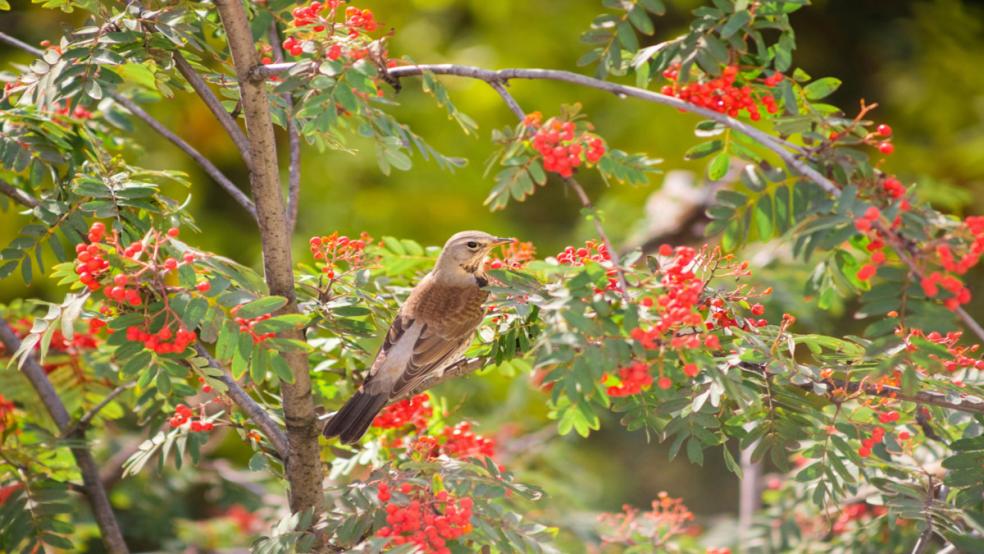
How to brighten your garden with berries and feed the birds at the same time
As autumn leaves fall and the days become shorter, many gardens are plunged into gloom.
One saving grace is berries – from reds and oranges to blacks – which brighten up the often colour-free winter garden, and provide vital food for birds. Many of them stand bold against evergreen leaves, providing an impressive display of contrast.
Rosehips last through winter
Berries, or hips, are a must for anyone who wants colour in their garden in the coldest months. And the first place to look is roses, some of which produce wonderful hips such as Rosa 'Scharlachglut' and Rosa x jacksonii 'Max Graf', which both produce a profusion of red hips.
Bright orange and red hues also come from Rosa moyesii, while darker hips, ranging from a deep chocolate colour to black, come from the burnet roses, Rosa pimpinellifolia.
When you are buying roses, do remember that not all of them produce hips, so you need to ask at your garden centre.
Keep it low-maintenance
Other common berry-producers include the easy-to-grow, low-maintenance cotoneaster, which provides a wealth of colour in winter. Its nutritious berries are feasted on by blackbirds, waxwings and thrushes.
Big-berried varieties include C microphyllus – the berries are as big as the leaves – which look even better if the frost clings to them, while C lacteus red berries will endure the harshest winter and C Rothschildianus produces bright yellow berries.
Deter intruders
A slightly harsher but no less colourful addition to the winter garden is the pyracantha. And if you're security-conscious, you might plant a few of these sharp-spiked plants in vulnerable spots to deter intruders.
But the berries will provide you with a wonderful show of colour. Try 'Orange Glow' for a splash of cheer against a drab backdrop, or 'Golden Dome' if you prefer yellow berries.
Check plant gender for berry success
Although holly berries are often ripe by autumn, birds such as song thrushes, blackbirds, fieldfares and redwings don't usually feed on them until late winter.
Many gardeners complain that their shrubs do not produce berries, and this is likely to be a problem of gender rather than any disease or weakness in the plant.
Most varieties of holly, for instance, carry the male and female flowers on separate plants, so one of each is required for fertilisation to take place.
To pollinate, the female has to have a male nearby. Many of the variegated cultivars are male and will never bear berries – and some of the names are misleading, such as 'Golden Queen', which is a male, while 'Golden King' and 'Indian Chief' are both female.
But there are varieties that are self-fertile, with male and female flowers, where one plant is therefore capable of producing berries. These include Ilex aquifolium 'J.C. van Tol', which produces bright red berries, and I. a. 'Pyramidalis', which is similar but with pale green leaves.
Display skimmias
Another wonderful shrub producing berries in autumn and winter is Skimmia japonica, but that also needs both male and female plants to produce its vibrant red berries, apart from the hermaphrodite S. japonica ssp. reevesiana, which has both male and female parts.
For a fabulous display of purple fruits, you need to grow a male variety near Gaultheria mucronata 'Stag River'.
Others which require a male to pollinate the fruit-bearing female include sea buckthorn (Hippophae rhamnoides), Aucuba japonica and Viburnum davidii, while trees and shrubs that bear ornamental fruit without needing two plants include Arbutus unedo, crataegus, malus, sorbus, pyracantha, cotoneaster, euonymus and berberis.
Dark and dramatic
Darker, more dramatic colours can be obtained from the berries of the berberis. Try B darwinii – it produces masses of blue-black fruits and is particularly suited to a light spot in the garden.
Other winter wonders – both for their delicious scents and their flowers and berries are viburnums.
V tinus has deep blue berries which contrast effectively with its evergreen leaves, while V opulus Xanthocarpum provides us with big bunches of yellow berries and makes a good hedging plant, and provides food for birds throughout winter.
Many viburnums do grow to quite a size, but you can get more compact versions which will give good shows of red berries, such as the slow-growing V opulus Compactum.
Winter doesn't have to be so drab after all.













